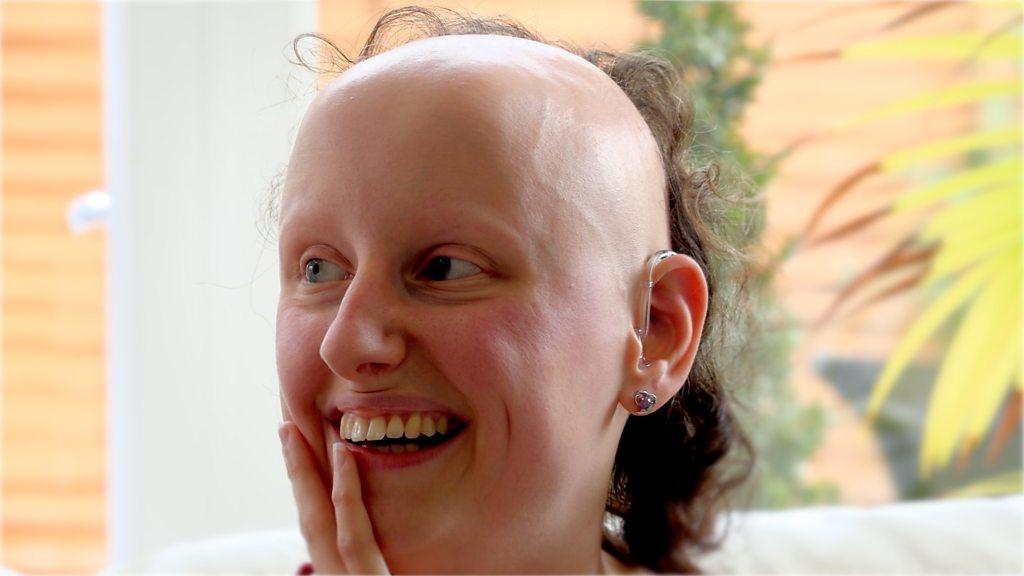Alopecia patients call for NHS to fund real hair wigs
- Published

People with alopecia want better access to good quality wigs to help with the psychological impacts of the condition
The NHS should fund real hair wigs for people with alopecia and better recognise the psychological impacts, people with the condition have said.
Julie Mees was diagnosed more than two years ago after her mother noticed a bald patch the size of a coin on the back of her head.
The hair loss has since worsened, and she will eventually be completely bald.
NHS Wales funds wigs for patients with hair loss but they are often made with synthetic hair.
The Welsh Government said health boards were given a list of approved suppliers to choose from for patients who have alopecia, burns or have lost hair because of treatments such as chemotherapy.
They also help patients with fitting and styling.
But it is up to each health board how much funding they provide - meaning people in some areas could be offered more to buy a wig than others.
Former lecturer Ms Mees, from Barry, said the £50 voucher she was given would only buy a synthetic wig from a specific shop, and she was not able to offset that against the cost of going private.
She saved £600 of her own money for a real hair topper - a type of mini wig.

Julie Mees has paid thousands for real hair wigs
"They give you a voucher to take to a shop for what I call a 'wiggy wig'... like a fancy dress costume, which look awful and do absolutely nothing for the person's emotional and psychological needs," she said.
"Your hair is the first thing people see... I've always had long hair, it's part of my identity.
"I'm losing it all and that's emotionally hard, it's very difficult.
"It's a case of if you have good finances, you can live life normally."
Ms Mees added those overwhelmed by the search for good quality wigs could end up paying over the odds, and she had since found a supplier for half the price she originally paid.
Moira Jones' 18-year-old son Thomas Barry, from Cardiff, has had alopecia universalis - complete loss of hair from the scalp and body. He started losing his hair when he was 11, and it was gone within three months.
Doctors believe his body is producing an allergic reaction, reacting as though hair is a disease - but no treatment has helped so far.

Thomas Barry wore beanie hats to hide his scalp throughout his teenage years, until he gained confidence to go without at 18
Ms Jones has paid more than £2,000 for two wigs for her son but neither was suitable. She said she was not helped by the NHS in her search and her son has never been offered counselling.
"He was really strong, stronger than everybody else around him," she added.
Thomas wore two beanie hats - in case one fell off - to hide his scalp during his teenage years, even during sleepovers and in the heat of summer.
When he went to Camp America last summer, his hair began to grow back in the sunshine - but fell out on his return to the UK.

Thomas Barry used to wear two beanies in case one fell off
While Thomas' experiences abroad have given him the confidence to go without a hat at university, Ms Jones feels the family should have received more support.
Cardiff and Vale health board said if a patient is deemed to require input from psychiatry then they will be referred to that team, and children will be referred to the child psychiatry.
Betsi Cadwaladr, Cwm Taf, Hywel Dda, Abertawe Bro Morgannwg, Cardiff and Vale and Aneurin Bevan health boards said they fund two wigs per person annually.
They said all suppliers go through a procurement process to ensure quality.
Powys health board has also been asked to comment.
Amy Johnson, from the charity Alopecia UK, external, said: "For many people with alopecia, wearing a wig is an essential part of managing the psychological impact of losing their hair; those who wear wigs for medical necessity don't see their wig as an optional luxury.
"The charity hears from individuals who struggle to go to work or school, or even leave the house. There should be provision within the NHS to support individuals with access to suitable wigs."

The different types of alopecia
Alopecia areata is understood to be an autoimmune condition, typically starting as one or more small, smooth bald patches. It can remain patchy or can continue until all hair on the scalp is lost or complete loss of hair from the body. Hair can re-grow, but there is no cure.
Androgenetic alopecia is often referred to as "male pattern hair loss" or "female pattern hair loss" and usually affects older men and women.
Scarring alopecias are a rare group of disorders that destroy hair follicles and replace them with scar tissue. The scarring is usually under the skin surface and the damage is permanent.
Telogen effluvium is hair shedding all over the scalp resulting in reduced volume, and usually resolves.
Anagen effluvium is sudden hair shedding usually due to radiation, chemotherapy, infection, drugs and toxins, and usually resolves within months of treatment ending.
Traction alopecia is usually due to excessive pulling as a result of certain hair styles and can lead to permanent hair loss.
Source: Alopecia UK
- Published21 November 2017

- Published19 September 2018

- Published4 September 2018
